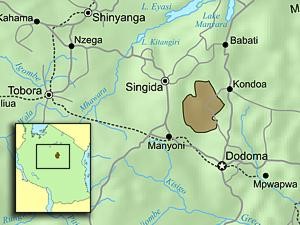
Population: 30,000 (estimated)
Location: Dodoma Region, Chemba District (between the Bubu and Mponde rivers)
Altitude: 1300 metres
Alternate names: Sandaweegki, Kisandawe
> Browse our Sandawe Project stories
Geography and Climate: Hilly bushland, very dry. The days are hot (about 35°C) and the nights pleasantly cool.
Cultural Information: Originally hunter-gatherers. Now mostly subsistence farmers, some have cattle.
Diet: Ugali (millet or corn mash), leafy vegetables and beans, occasionally goat meat, chicken, or beef.
Average Income: Unless someone has a job as a teacher, or government worker, or shop owner, they have no income.
“Home is where you live,” someone said. Imagine having a daily ritual of walking a well to get water for yourself and your family. It is a shallow well, dug in the sand, in which water gathers very slowly. As the water table sinks in the dry season you have to make your well deeper and deeper and sometimes wait for hours until you can fill your buckets. When this proves too difficult you set off to get water from the village pump. Although you have to pay a fee and the water tastes slightly salty it’s better than nothing. When you arrive, however, the village pump is broken.
When the shallow wells are dry and the village pump broken, it is a serious problem. People have to walk further to neighboring villages in hopes there will be water there. This scenario repeats itself at irregular intervals over the years. Whenever the water table falls and digging in the sand doesn’t yield the precious commodity, the demand for water from the village pumps increases.
Some years, the conditions become so desperate that the Sandawe are faced with a famine. However, God loves the Sandawe people and desires that they hunger and thirst for the truth and come to Him with their needs.
The language of the Sandawe people is very different from their neighbors, as Sandawe is classified as a Khoisan, or click language. The Sandawe language is very complex and quite difficult to read and write. Adult literacy rate in the national language Swahili is 80%, but in practice very few Sandawe are active readers. Bible Translation work among the Sandawe is continuing at a slow but steady pace.
Literacy Information: Most school-aged children attend local schools that are taught in Swahili. About 30% go on to secondary school. Adult literacy rate is approximately 80%.
Religion: Roman Catholic, Traditional religion, Islam, and (some) evangelical Christian. History: Some scholars believe that the Sandawe people are indigenous to their current region, rather than being relatively recent migrants from the south. It is thought that the Sandawe are a remnant of the San people that once covered the whole of eastern and southern Africa. The Hadza, another people group found in Tanzania with a click language, are also believed to be a part of that remnant.
The Complexities of the Language
- Sandawe is a click language from the Khoisan language family.
- The language has fifteen different clicks that have the same status as ‘regular’ consonants like b, p, t and d.
- Learning Sandawe is very difficult because it is so different from how Swahili or English sounds and is written. Also, the sentence structure is completely different.
- Sandawe is difficult to read and even more difficult to write because of the use of clicks in its consonant inventory. Moreover, it has a complex way of changing words into different types of words – verbs into nouns, adjectives into verbs, nouns into adjectives, and so on.
- The fact that the language differs so much from other languages spoken in the country, makes it very hard for a Sandawe pupil to study in Swahili, or even in English!
- There is only one other click language in Tanzania and it is not closely related to Sandawe.
Progress of Language Work
Writing down a traditionally oral language has taken a tremendous amount of time and effort. However a solid foundation has been laid largely thanks to linguist Helen E. The team consisting of her, Daniel and Elizabeth H and three Sandawe coworkers who helped at various stages, Nestori, Odilo and Rogart; has been able to complete so far:
- Phonology statement
- Description of the Grammar
- Dialect survey
- Sandawe Alphabet and Orthography statement (rules of writing the language)
- Database of words for dictionary
Translation
So far, the books of Genesis, Ruth, Jonah, Luke and Acts have been translated. The team is currently working on the letter of Paul to the Galatians.
All the translated books have been recorded and therefore been made available not only in written, but also in audio format. The Gospel of Luke has been used to dub the Luke film into the language of the Sandawe. This is the same footage as the more widely known Jesus film, only it covers pretty close to the whole book of Luke.
Literacy and the use of oral media
The literacy program has remained small. A few reading classes have been conducted with a small number attending. Some ground has been gained with the annual production of a calendar. But the main challenge is that most people don’t see a reason as to why they should learn to read or how it could help them.
Because of this, the team has chosen a more oral approach for getting the translated word out into the communities. This includes:
- Distributing solar powered audio players with the translated Scriptures on them, so that a wider range of listeners can benefit from them.
- Show the Luke film around the Sandawe area, putting on open air film nights.
- Continue to teach those that have a desire to learn to read. Hopefully the above will result in more motivation to do so. Our prayer is that this will include as many Christians as possible because the translated Bible portions will benefit them.
> Browse our Sandawe Project stories
